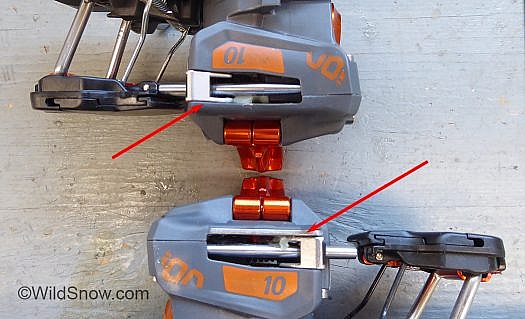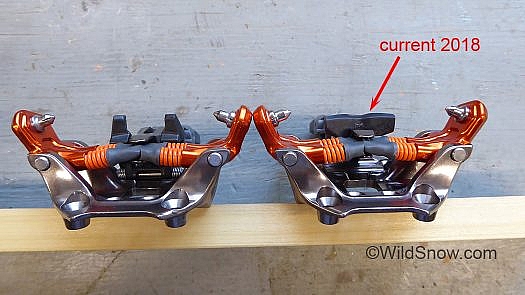G3 has made a few “in line” changes over the retailing history of the ION ski touring binding, not to mention a recall. In my opinion most of this is important — if you find bindings on sale this spring be sure you’re getting current hardware. Below shows how to ID the latest versions of the ION 10 and 12 (those with brakes).
(From what we’ve seen, the LT version of the ION (sold without brakes) is less subject to changes. Near as we can tell, most any LTs you find in retail are fine. If you’re looking at a pair of LT (new or used) be aware you’re not getting the latest unless the top plate/cap on the heel unit is grey plastic with a little metal showing on the edge where it mates with the lower heel unit housing. Overall, considering the sordid history of tech binding defects, buying used bindings of nearly any brand is problematic. If you choose to buy used, do the best you can with Google and enlist the help of knowledgeable shop employees who unfortunately bear the brunt of cracking metal and exploding plastic. See the bottom of this post for more about the LT version.)
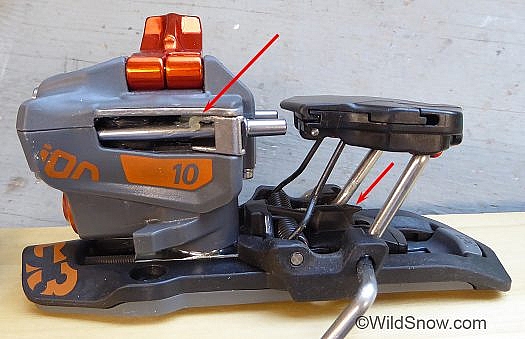
The two most visible differences, in my opinion. Thickened cap on the heel unit, with exposed metal, and differently shaped brake retraction hook. Improvements such as rotation lock are not easily visible.
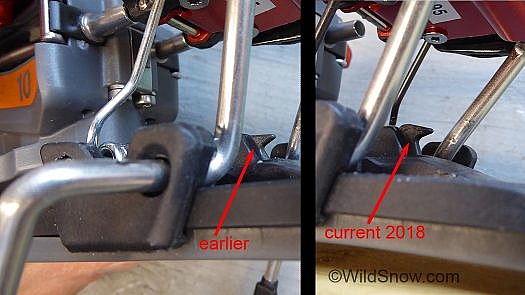
Brake hook comparison, the latest (right) also has a stronger hidden spring. We’re not surprised to see this, as an ongoing though not pervasive problem with G3 ION brakes has been their popping into downhill mode while you’re touring uphill. We assume the “hook” changes remedy this once and for all. Note the black brake spring on new version. It’s said to be stronger. We measured and it’s indeed slightly stiffer, but not by a huge margin. Latest version of LT is not as easily identified, look for small amount of visible metal on the edge of the heel unit cap, and check for the anti-rotation feature.
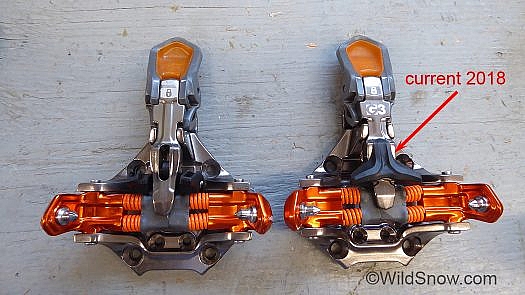
Only change we could see with the toe is a different boot toe locator, made from soft instead of rigid plastic. The LT has a boot locator as well, only smaller and easily mistaken for cosmetics.
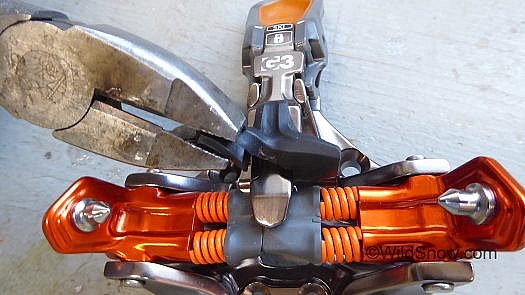
Nice things about the new locator: Weighs about 4 grams less than the older style, and can be easily removed with a bit of razor action (we don’t like these things).
One other thing. It’s hard to spot, but the latest IONs have a slick anti-rotation feature built into the heel unit. How this works: after you rotate the heel to touring mode and lock up the brake, the first time you step on the heel unit it drops down a few millimeters and engages a clever little lock, for 100% zero none nada possibility of rotating while touring. This is a must-have feature in my opinion. Only gotcha is when changing mode to downhill you have to remember to pull up on the heel unit before you attempt to rotate it to downhill skiing position, otherwise you’ll struggle and wonder just why it’s so difficult to spin.
(Note: To repeat and clarify for those new to G3 products, ION LT has no brake and thus none of the brake related changes. It has a smaller, low profile boot toe locator as well as the the visible metal layer in the heel unit top cover. Latest version *does* have the anti rotation lock feature. LT has always been our favorite ION, now more than ever.)
WildSnow.com publisher emeritus and founder Lou (Louis Dawson) has a 50+ years career in climbing, backcountry skiing and ski mountaineering. He was the first person in history to ski down all 54 Colorado 14,000-foot peaks, has authored numerous books about about backcountry skiing, and has skied from the summit of Denali in Alaska, North America’s highest mountain.

